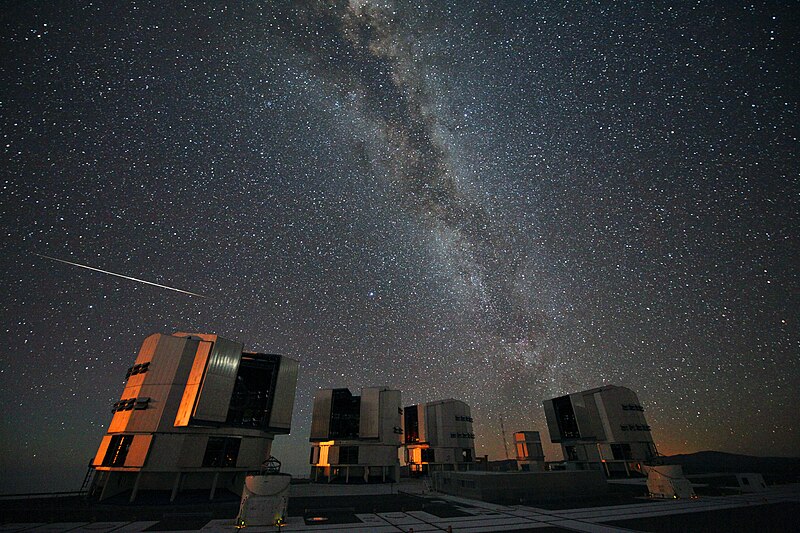Fasciculus:The 2010 Perseids over the VLT.jpg

Mensura huius perspectionis: 800 × 533 elementa imaginalia. Aliae mensurae: 320 × 213 elementa imaginalia | 640 × 427 elementa imaginalia | 1 024 × 683 elementa imaginalia | 1 280 × 853 elementa imaginalia | 2 560 × 1 707 elementa imaginalia | 5 616 × 3 744 elementa imaginalia.
Sua resolutio (5 616 × 3 744 elementa imaginalia, magnitudo fasciculi: 5.68 megaocteti, typus MIME: image/jpeg)
Historia fasciculi
Presso die vel tempore fasciculum videbis, sicut tunc temporis apparuit.
| Dies/Tempus | Minutio | Dimensiones | Usor | Sententia | |
|---|---|---|---|---|---|
| recentissima | 17:32, 19 Februarii 2024 |  | 5 616 × 3 744 (5.68 megaocteti) | C messier | full size |
| 09:34, 18 Augusti 2010 |  | 4 000 × 2 667 (5.82 megaocteti) | Lars Lindberg Christensen | {{Information |Description={{en|1=Every year in mid-August the Perseid meteor shower has its peak. Meteors, colloquially known as “shooting stars”, are caused by pieces of cosmic debris entering Earth’s atmosphere at high velocity, leaving a trail o |
Nexus ad fasciculum
Ad hunc fasciculum nectit:
Usus fasciculi per inceptus Vicimediorum
Quae incepta Vici fasciculo utuntur:
- Usus in af.wikipedia.org
- Usus in ar.wikipedia.org
- Usus in en.wikipedia.org
- Usus in eo.wikipedia.org
- Usus in es.wikipedia.org
- Usus in fa.wikipedia.org
- Usus in gl.wikipedia.org
- Usus in he.wikipedia.org
- Usus in hr.wikipedia.org
- Usus in hu.wikipedia.org
- Usus in it.wikipedia.org
- Usus in mk.wikipedia.org
- Usus in ml.wikipedia.org
- Usus in ms.wikipedia.org
- Usus in my.wikipedia.org
- Usus in nn.wikipedia.org
- Usus in pl.wikipedia.org
- Perseidy
- Portal:Astronomia/Artykuł miesiąca 08 2012
- Portal:Astronomia/Artykuł miesiąca 08 2013
- Portal:Astronomia/Artykuł miesiąca 08 2014
- Portal:Astronomia/Artykuł miesiąca 08 2015
- Portal:Astronomia/Artykuł miesiąca 08 2016
- Portal:Astronomia/Artykuł miesiąca 08 2017
- Portal:Astronomia/Artykuł miesiąca 08 2018
- Portal:Astronomia/Artykuł miesiąca 08 2019
- Portal:Astronomia/Artykuł miesiąca 08 2020
- Portal:Astronomia/Artykuł miesiąca 08 2021
- Portal:Astronomia/Artykuł miesiąca 08 2022
- Usus in ro.wikipedia.org
- Usus in sh.wikipedia.org
- Usus in sk.wikipedia.org
- Usus in sl.wikipedia.org
- Usus in sv.wikipedia.org
- Usus in tr.wikipedia.org
- Usus in vi.wikipedia.org
- Usus in www.wikidata.org
- Usus in zh.wikipedia.org
